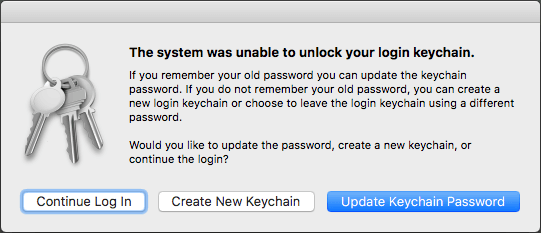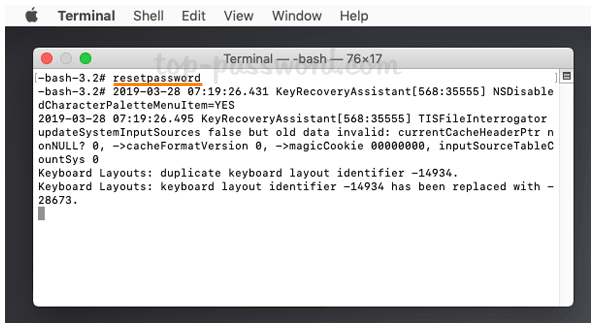The password of your macOS user account is also known as your login password. It's the password that you use to log in to your Mac and make certain changes, such as installing software.

Change your password
- Click Apple icon and Go to System Preferences. Now click Users & Groups. You will get Users & Groups window, click padlock sign at the bottom left corner and enter a.
- Every Mac has a built-in Recovery mode that will let you change the system password if it's been forgotten. Read our How to recover a forgotten Mac password tutorial for a step-by-step guide to.
- Step 1 Double-click on the download button above to free install and run this Screen Time passcode erasing software on your computer. As you can see, it offers a Screen Time option for you to bypass Screen Time app. Step 2 Click Start button and then connect your iPhone to it with a standard USB cable. On your iPhone screen, tap Trust this computer to help your computer recognize this iOS device.
If you know your password and can use it to log in to your account, you can change your password in Users & Groups preferences:

Bypass Windows 10 Password When You're Logining. Generally, creating a password for your.
Bypass Password Macbook Pro
- Choose System Preferences from the Apple menu, then click Users & Groups.
- Select your user name from the list of users.
- Click the Change Password button, then follow the onscreen instructions.
Reset your password
If you don't remember your password, or it isn't working, you might be able to reset it using one of the methods described below. But first try these simpler solutions:
- Make sure that you're typing the correct uppercase or lowercase characters. If your keyboard has Caps Lock turned on, the password field shows a Caps Lock symbol .
- If the password field shows a question mark, click it to display a password hint that might help you to remember.
- Try to log in without a password. If that works, you can then add a password by following the steps to change your password.
- Try to log in with the Apple ID password that you use for iCloud. If you just changed that password and the new password isn't working, try the old password first. If that works, you should be able to use the new password from then on.
Reset using your Apple ID
In some macOS versions, you can use your Apple ID to reset your login password. At the login screen, keep entering a password until you see a message saying that you can reset your password using Apple ID. If you don't see the message after three attempts, your account isn't set up to allow resetting with Apple ID.
- Click next to the Apple ID message, then follow the onscreen instructions to enter your Apple ID and create a new password. You'll be asked to restart when done.
- Log in with your new password.
- Determine whether to create a new login keychain.
Reset using another admin account
If you know the name and password of an admin account on your Mac, you can use that account to reset the password.
Password Bypass Mac
- Log in with the name and password of the other admin account.
- Choose System Preferences from the Apple menu, then click Users & Groups.
- Click , then enter the admin name and password again.
- Select your user name from the list of users.
- Click the Reset Password button, then follow the onscreen instructions to create a new password:
- Choose Log Out from the Apple menu.
- Log in to your account using your new password.
- Determine whether to create a new login keychain.
Reset using the Reset Password assistant (FileVault must be on)
If FileVault is turned on, you might be able to reset your password using the Reset Password assistant:
- Wait up to a minute at the login screen, until you see a message saying that you can use the power button on your Mac to shut down and start up again in Recovery OS. If you don't see this message, FileVault isn't on.
- Press and hold the power button until your Mac turns off.
- Press the power button again to turn on your Mac.
- When the Reset Password window appears, follow the onscreen instructions to create a new password.
If you need to connect to Wi-Fi, move your pointer to the top of the screen and use the Wi-Fi menu to connect. To exit without resetting your password, choose Apple menu > Restart. - When done, click Restart.
- If you were able to reset your password with the Reset Password assistant, log in to your account using your new password.
- Determine whether to create a new login keychain.

Reset using your Recovery Key (FileVault must be on)
If FileVault is turned on and you have a FileVault Recovery Key, you can use that key to reset your password.
- At the login screen, keep entering a password until you see a message saying that you can reset your password using your Recovery Key. If you don't see the message after three attempts, FileVault isn't on.
- Click next to the message. The password field changes to a Recovery Key field.
- Enter your Recovery Key. Use uppercase characters, and include the hyphens.
- Follow the onscreen instructions to create a new password, then click Reset Password when done.
- Determine whether to create a new login keychain.
If you can't log in with your new password after restarting your Mac, take these additional steps:
- Restart again, then immediately hold down Command-R or one of the other macOS Recovery key combinations until you see the Apple logo or a spinning globe.
- When you see the macOS Utilities window, choose Utilities > Terminal from the menu bar.
- In the Terminal window, type
resetpassword, then press Return to open the Reset Password assistant pictured above. - Select ”My password doesn't work when logging in,” then click Next and follow the onscreen instructions for your user account.
Create a new login keychain, if necessary
After resetting your password and logging back in to your account, you might see an alert that the system was unable to unlock your login keychain. This is expected, because the passwords for your user account and login keychain no longer match. Just click the Create New Keychain button in the alert.
If you didn't see an alert about your login keychain, or you see other messages asking for your old password, reset your keychain manually:
- Open Keychain Access, which is in the Utilities folder of your Applications folder.
- Choose Preferences from the Keychain Access menu, then click the Reset My Default Keychain button in the preferences window. After you enter your new password, Keychain Access creates an empty login keychain with no password. Click OK to confirm.
If you don't see a Reset My Default keychain button, close the preferences window and select the “login” keychain from the left side of the Keychain Access window. Press the Delete key, then click Delete References. - Choose Log Out from the Apple menu to return to the login screen.
- Log in to your account using your new password. Your account password and login keychain password now match again.
If you still can't log in

If you still can't log in with your password, contact Apple Support for help.
The firmware password prevents starting from any internal or external storage device other than the selected boot disk.
To protect data on your Mac, you can set a user account password (password to log in) to prevent other users from unauthorized access to your account. You can also encrypt a boot disk using FileVault so that only users who log on to a Mac can read data from this disk.
For even more reliable protection, you can set the firmware password. Users who do not know the password of the firmware will not be able to start the computer from any disk other than the one designated as the boot disk. Thus, it will be impossible to use some shortcut keys at startup.
If you Forgot your Firmware Password
Bypass Firmware Password on any MacBook or MacBook Air, or iMac it’s a very dangerous and hard procedure. If you cannot remember the firmware password or pass code, reserve a personal meeting with an Apple Store Members or an authorized Apple Service Center. Bring your Mac and your original receipt or invoice as proof of purchase.
Read more: How to Reset Mac to Factory Settings?
Solving the Problem by Yourself
It is extremely important to understand that rolling back the EFI firmware is the MOST dangerous operation that you can do on a Mac. If you confuse the image of EFI firmware and initiate an update with firmware from the wrong generation or, even worse, from a different Mac model, it will not end with anything good, and even in an authorized service center you can hardly be helped. The computer risks to stop turning on altogether, once and forever.
Bypass Mac Admin Password
Conclusion
Reset Password For User In Mac Air
In general, I warned you and I strongly recommend to contact the authorized Apple Center to solve this problem. Please, don’t try to reset Mac Firmware Password by yourself!
